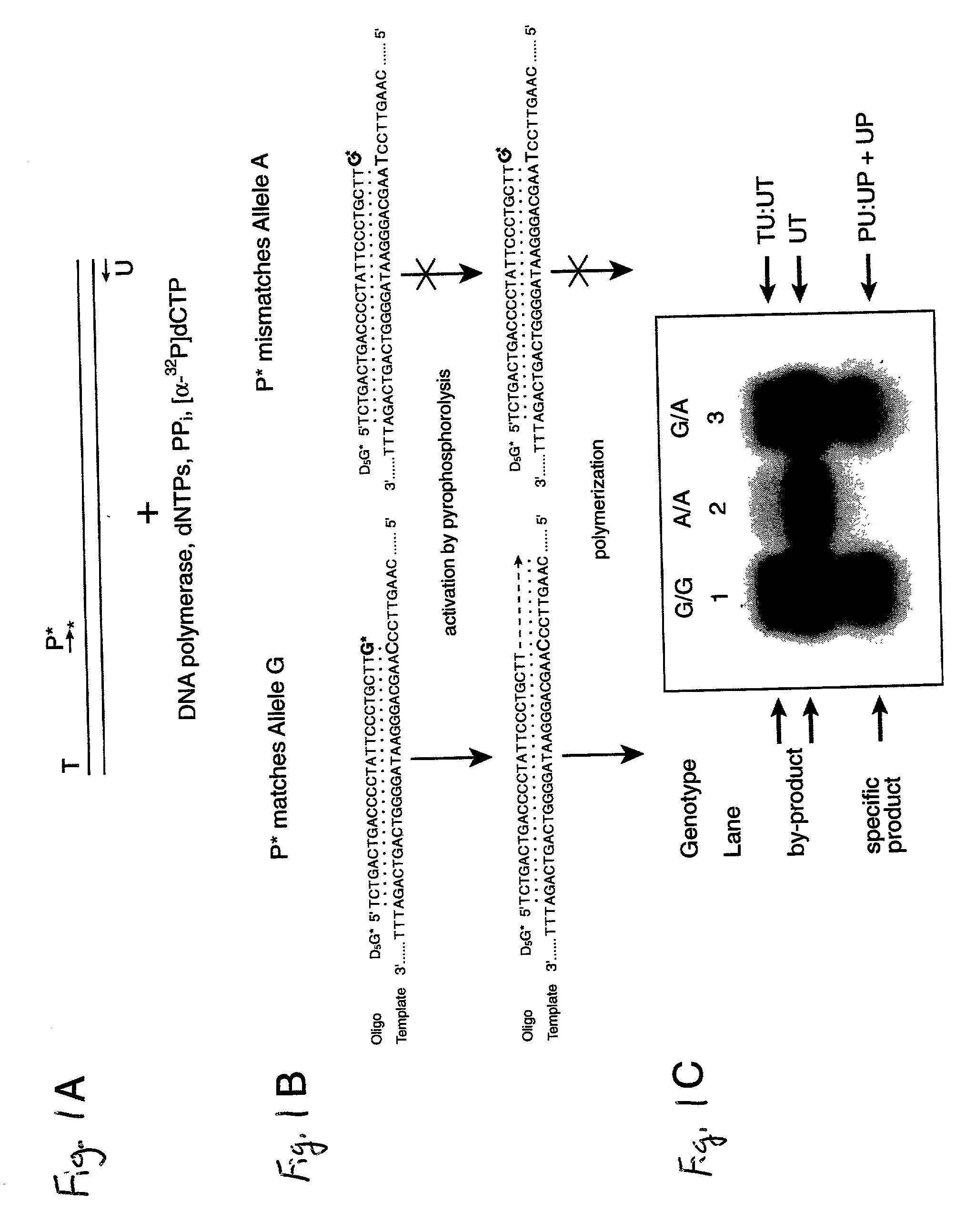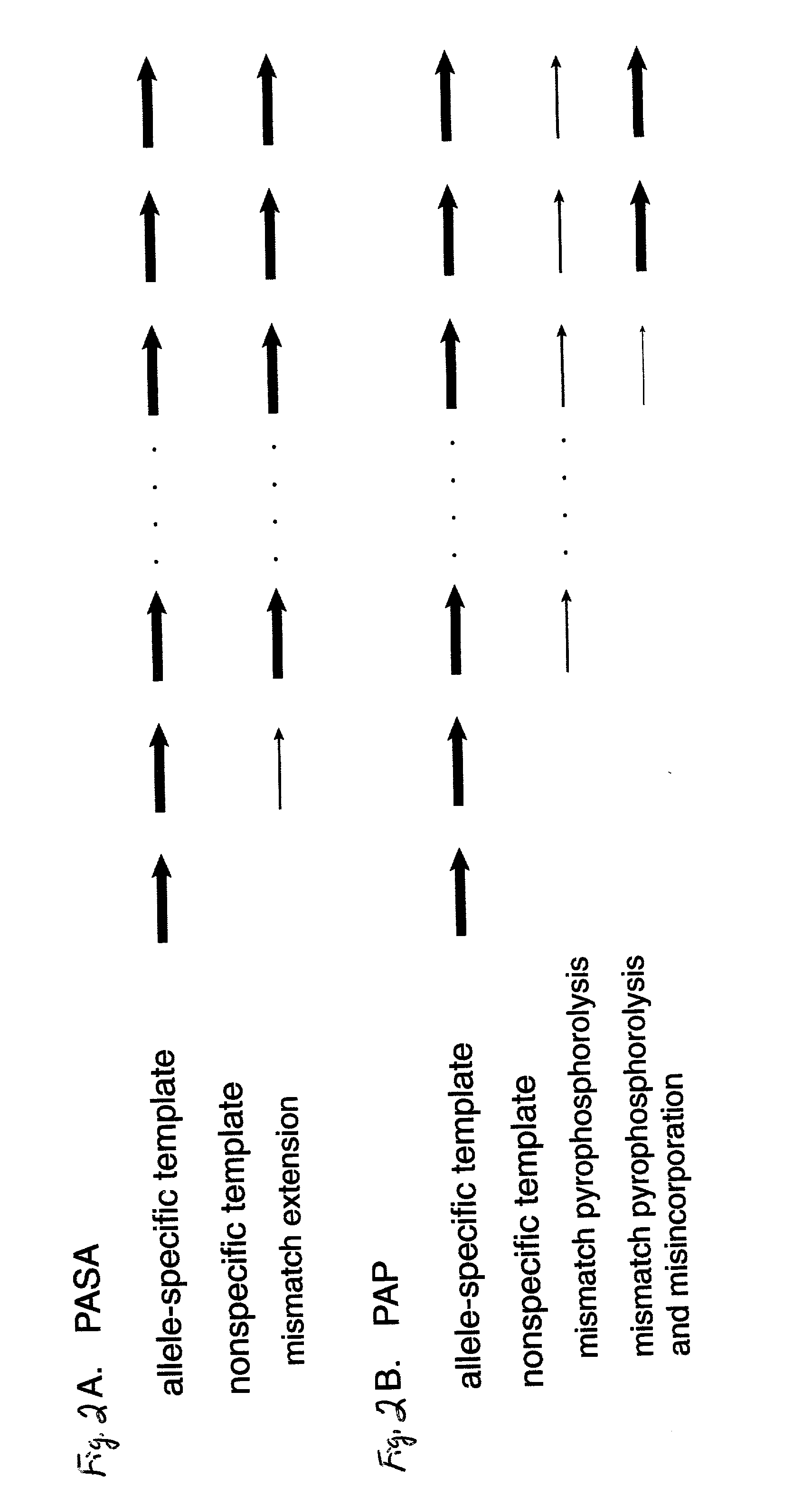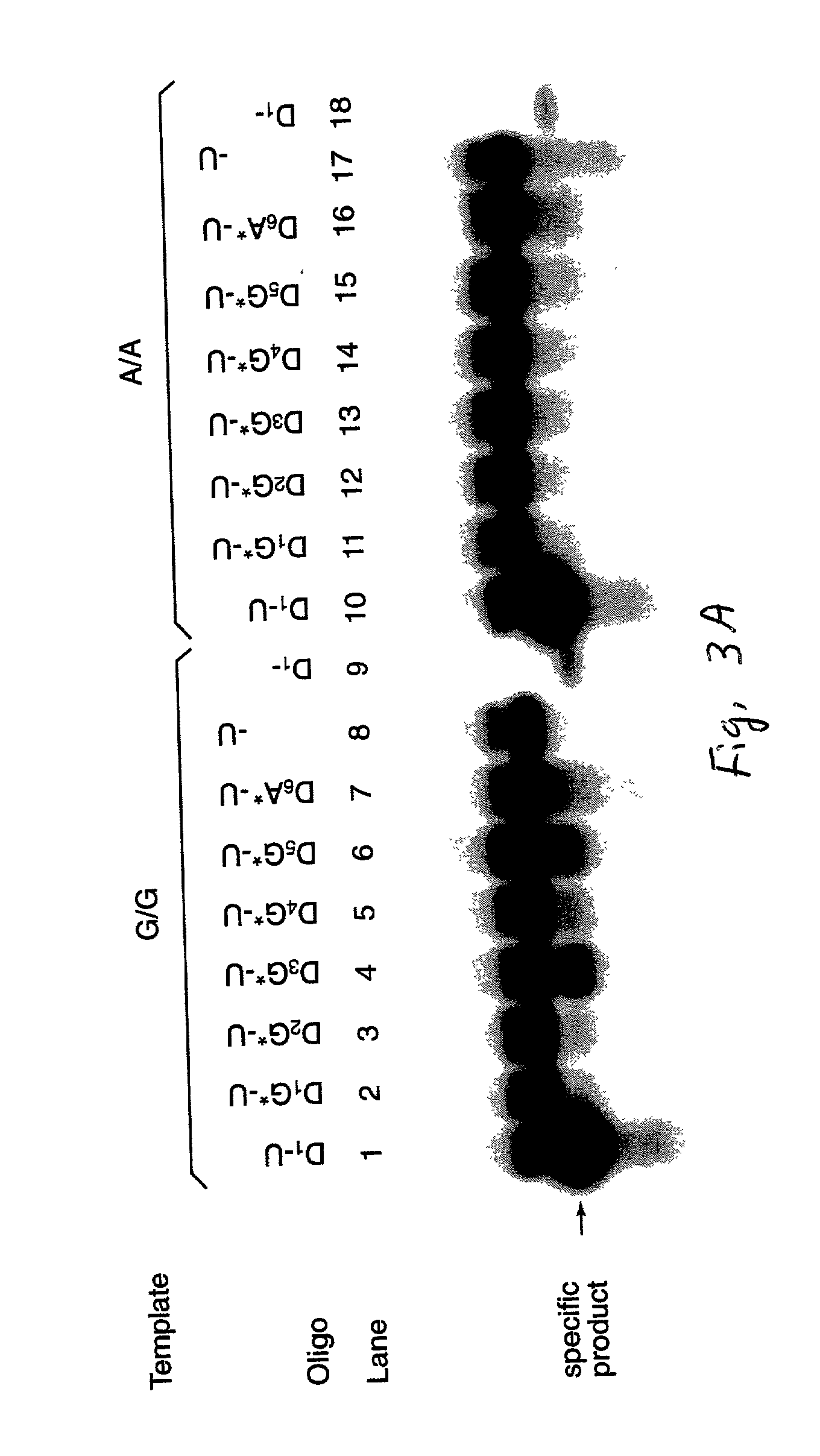Pyrophosphorolysis activated polymerization (PAP): application to allele-specific amplification and nucleic acid sequence determination
- Summary
- Abstract
- Description
- Claims
- Application Information
AI Technical Summary
Benefits of technology
Problems solved by technology
Method used
Image
Examples
example 1
[0057] Preparation of Template by PCR
[0058] A 640-bp region of the human D.sub.1 dopamine receptor gene was amplified by PCR with two primers (T=5' GAC CTG CAG CAA GGG AGT CAG AAG 3' (SEQ ID NO:1) and U=5' TCA TAC CGG AAA GGG CTG GAG ATA 3' (SEQ ID NO:2)) (FIG. 1A). The TU:UT duplexed product spans nucleotides 33 to 672 in GenBank X55760 and the G+C content is 55.3%. A common A to G polymorphism is located at nucleotide 229, resulting in three genotypes of G / G, A / A and G / A (12). The PCR mixture contains a volume of 50 .mu.l: 50 mM KCl, 10 mM Tris / HCl, pH 8.3, 1.5 mM MgCl.sub.2, 200 .mu.M each of the four dNTPs (Boehringer Mannheim), 0.1 .mu.M of each primer, 2% DMSO, 1 U of Taq DNA polymerase (Boehringer Mannheim) and 250 ng of genomic DNA from G / G homozygote, A / A homozygote or G / A heterozygotes. Cycling conditions included: denaturation at 95.degree. C. for 15 seconds, annealing at 55.degree. C. for 30 seconds, and elongation at 72.degree. C. for one minute, for a total of 35 cycle...
example i
[0085] Example I provides evidence that pyrophosphorolysis followed by polymerization may be used to increase the specificity of PASA. Significant nonspecific amplification requires the serial coupling of the two types of errors (FIG. 2). The mismatch pyrophosphorolysis rate to remove a mismatch deoxynucleotide at the 3' terminus, expressed as the removal rate of an incorrect versus a correct dNMP, was reported at less than 10.sup.-5 for T7 DNA polymerase (6, 13). The misincorporation rate to create a substitution mutation by polymerization, expressed as the incorporation rate of an incorrect versus a correct dNMP, was reported as to be 10.sup.-5 for T7 DNA polymerase and to be 10.sup.-4 for E.coli DNA polymerase I (6, 13, 14). Similar results were reported for Taq DNA polymerase and for 3'-5' exonuclease-deficient mutants of T7 DNA polymerase and E. coli DNA polymerase I (6, 13, 15). The specificity due to the (i) nonspecific amplification in PAP with D.sub.5G* is estimated to be 1...
example 2
[0101] Preparation of Template by PCR
[0102] A 640-bp region of the human D.sub.1 dopamine receptor gene was amplified by PCR with two primers (T=5'GAC CTG CAG CAA GGG AGT CAG AAG 3' (SEQ ID NO:1) and U=5' TCA TAC CGG AAA GGG CTG GAG ATA 3' (SEQ ID NO:2)). The TU:UT duplexed product spans nucleotides 33 to 672 in GenBank X55760 and the G+C content of the product is 55%. A common A to G polymorphism is located at nucleotide 229, resulting in three genotypes of G / G, A / A and G / A". The PCR volume is 50 .mu.t: 50 mM KCl, 10 mM Tris / HCl, pH 8.3, 1.5 mM MgCl.sub.2, 200 .mu.M each of the four dNTPs, 0.1 .mu.M of each primer, 2% DMSO, 1 U of Taq DNA polymerase (Boehringer Mannheim) and 250 ng of genomic DNA from G / G homozygote, A / A homozygote or G / A heterozygotes. Cycling conditions included: denaturation at 94.degree. C. for 15 sec., annealing at 55.degree. C. for 30 sec., and elongation at 72.degree. C. for one min., for a total of 35 cycles with a GeneAmp PCR System 9600 (Perkin Elmer Appl...
PUM
| Property | Measurement | Unit |
|---|---|---|
| Dynamic viscosity | aaaaa | aaaaa |
| Dynamic viscosity | aaaaa | aaaaa |
| Dynamic viscosity | aaaaa | aaaaa |
Abstract
Description
Claims
Application Information
 Login to View More
Login to View More - R&D
- Intellectual Property
- Life Sciences
- Materials
- Tech Scout
- Unparalleled Data Quality
- Higher Quality Content
- 60% Fewer Hallucinations
Browse by: Latest US Patents, China's latest patents, Technical Efficacy Thesaurus, Application Domain, Technology Topic, Popular Technical Reports.
© 2025 PatSnap. All rights reserved.Legal|Privacy policy|Modern Slavery Act Transparency Statement|Sitemap|About US| Contact US: help@patsnap.com



